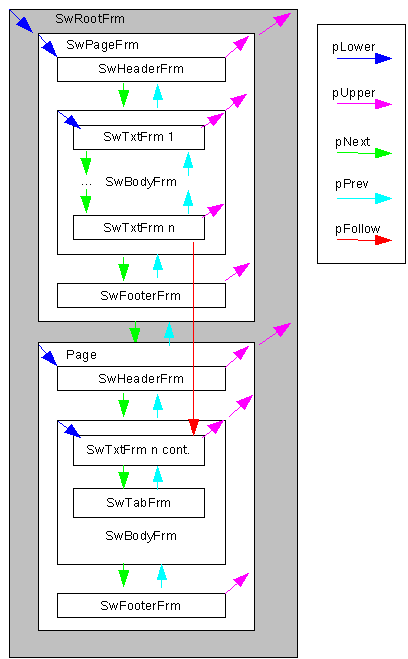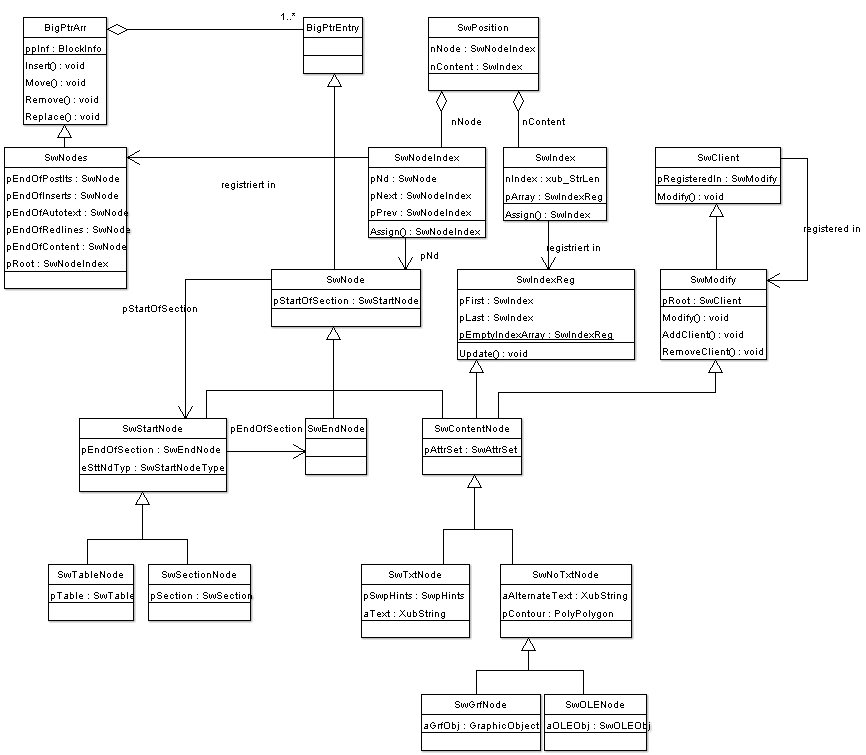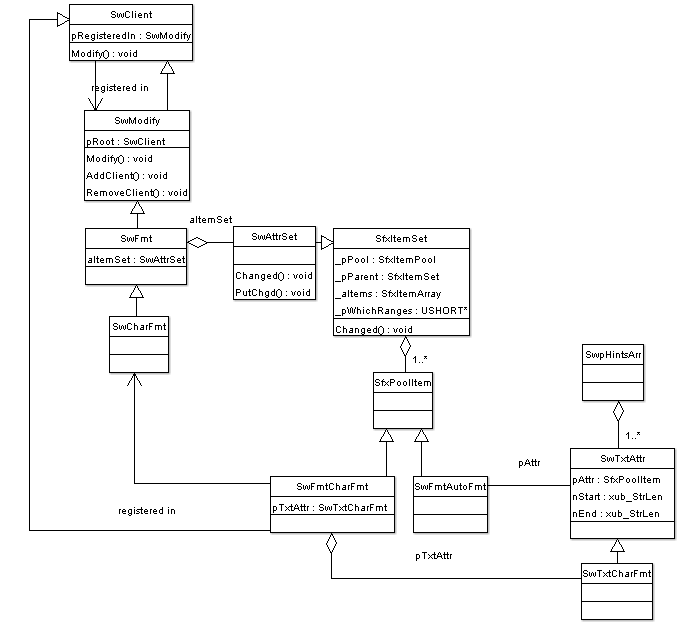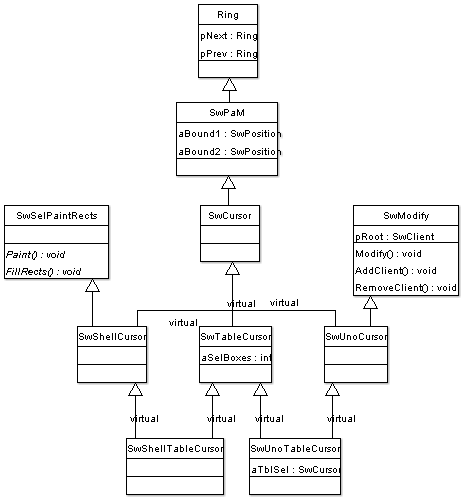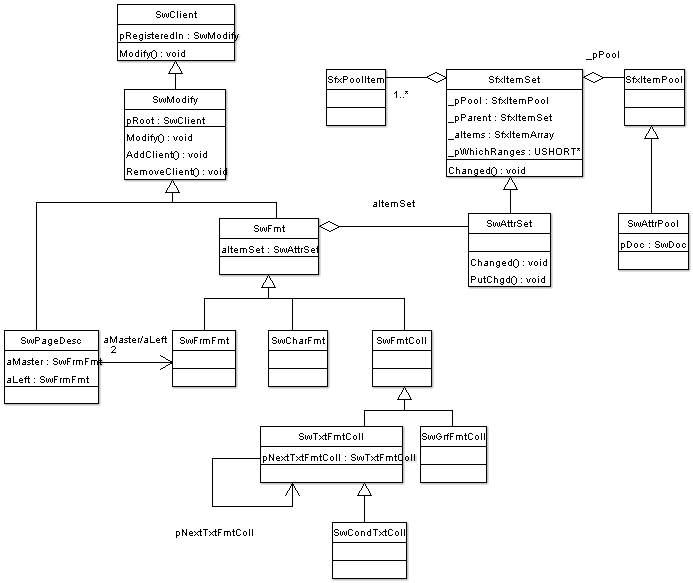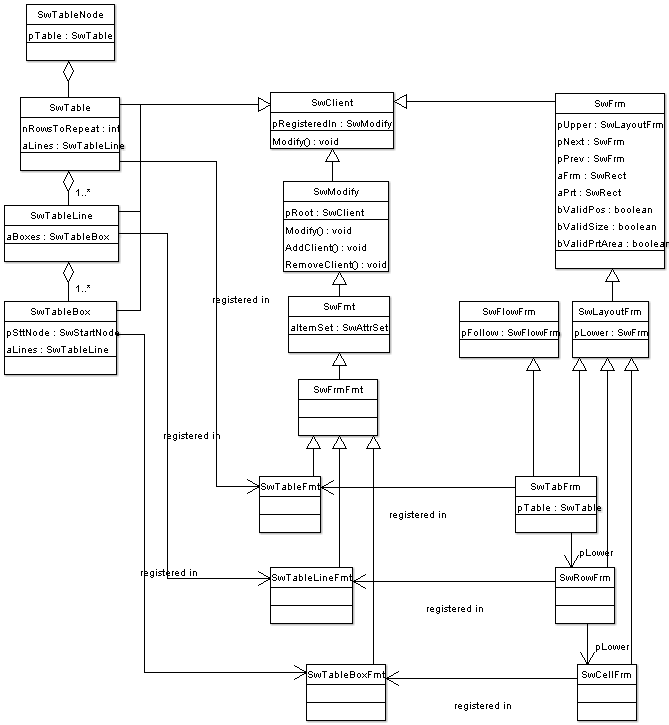Writer/Core And Layout
|
Please view the guidelines
|
|---|
|
Popular Subcategories: Extension:DynamicPageList (DPL), version 2.3.0 : Warning: No results. Internal Documentation: Extension:DynamicPageList (DPL), version 2.3.0 : Warning: No results. API Documentation: Ongoing Efforts: Extension:DynamicPageList (DPL), version 2.3.0 : Warning: No results. Projects on this Wiki: (edit list)
|
| Sw.OpenOffice.org |
Contents
About Frames - Writer layout
The layout is the visual representation of a Writer document. Basically a frame is a rectangular area which is linked with other frames:
Bold text The base class of the frame hierachy is SwFrm, which is derived from SwClient for inheriting the ability of being notified by changes.
| SwFrm : SwClient |
| pRegisteredIn : SwModify* |
| pUpper : SwFrm* |
| pNext : SwFrm* |
| pPrev : SwFrm* |
| aFrm : SwRect |
| aPrt : SwRect |
| bValidPos : bool |
| bValidSize : bool |
| bValidPrtArea : bool |
A layout frame has an additional member pLower, i.e., a layout frame is a frame that contains other frames. Incarnations of a layout frame are pages, tables, ...
| SwLayoutFrm : SwFrm |
| pLower : SwFrm* |
Some frames are not only derived from SwFrm, but also from SwFlowFrm. These are the frames that are allowed at page breaks and shall continue on the next page, e.g., paragraphs, tables, ...
| SwFlowFrm |
| rThis : SwFrm& |
| pFollow : SwFlowFrm* |
The most important frame is the SwTxtFrm, which is the layout counterpart a SwTxtNode object. The nOfst member referes to the aText string member of the associated SwTxtNode object. A SwTxtFrm object is registered in a SwTxtNode object in order to be notified in case the SwTxtNode object is changed.
| SwTxtFrm : SwFrm |
| nOfst : xub_StrLen |
A page frame additionally has a couple of boolean members to indicate if any of the page contents is invalid. These flags are used during formatting of the document.
| SwPageFrm |
| bInvalidLayout : bool |
| bInvalidContent : bool |
| bInvalidFly : bool |
Some notes about anchored objects:
Anchored objects are inserted differently into the layout. A anchored object, like text frames, graphics, OLE objects and drawing objects, are anchored at a certain <SwFrm> instance. Such instances are <SwPageFrm> for at-page anchored objects, <SwTxtFrm> for at-paragraph, at-character and as-character anchored objects and <SwFlyFrm> for at-frame anchored objects. Anchored objects are represented by instances of <SwAnchoredObject> in the layout. Sub classes are <SwFlyFrm> - base class for Writer anchored objects - and <SwAnchoredDrawObject> - class for drawing objects. <SwFlyFrm> is also a sub class of <SwFrm>. <SwFlyFrm> has the following subclasses <SwFlyFreeFrm>, <SwFlyLayFrm>, <SwFlyAtCntFrm> and <SwFlyInCntFrm>. The layout structure for anchored objects is build by member <pDrawObjs> at <SwFrm> and member <mpAnchorFrm> at <SwAnchoredObject>. <pDrawObjs> is list of <SwAnchoredObject> instances, representing the anchored objects, which are anchored at this <SwFrm> instance. <mpAnchorFrm> is a pointer to a <SwFrm> instance representing the anchor frame of the <SwAnchoredObject> instance. The <pDrawObjs> list of the <SwPageFrm> instance also contains all <SwAnchoredObject> instances, which are anchored at the lowers of the <SwPageFrm> instance, except the as-character anchored objects.
Some basics about the layout algorithm:
Main purpose of the layout algorithm is to determine the values for <aFrm> and <aPrt> of the <SwFrm> instances of a certain layout. The main methods of the layout algorithm are ::MakeAll(), ::MakePos(), ::Format(), ::MakePrtArea() at the <SwFrm> class and its subclasses. These are the main entry points into the layout algorithm. To debug the layout algorithm it is useful to have breakpoints in these methods and investigate the change of <aFrm> and <aPrt>. In order to get familiarized with the layout algorithm debugging simple text documents is appropriate. Such as a one containing a couple of paragraphs, then some more paragraphs on two pages, then mixing in some tables and so on. Afterwards documents containing page header and page footer, footnotes, sections, columned sections, columned balanced sections, anchored objects, etc.
Some Notes about Nodes
A SwDoc object, which denotes the model of a Writer document, has as member of Type SwNodes, which stores the document content. The SwNodes object of an empty Writer document looks like this:
SwStartNode (special start-end-section, not used) SwEndNode SwStartNode (special start-end-section used for footnotes) SwEndNode SwStartNode (special start-end-section used for frames, headers, footers) SwEndNode SwStartNode (special start-end-section used for 'delete' redlines if they are not shown) SwEndNode SwStartNode (special start-end-section for 'regular' document content) SwTxtNode (there always at least one empty paragraph in the document) SwEndNode
Even if SwNodes is an array, it gets a kind of tree structure because of the start (and end) nodes.
Every SwNode has a member pStartOfSection. This is a pointer to the "upper" SwStartNode.
E.g. if a text node is inside a section, the section inside a table, the table inside a header, we will get the following pStartOfSection pointers:
aTxtNode.pStartOfSection -> aSectionNode aSectionNode.pStartOfSection -> aTableBoxStartNode aTableBoxStartNode.pStartOfSection -> aTableNode aTableNode.pStartOfSection -> aHeaderStartNode aHeaderStartNode.pStartOfSection -> aNormalStartNode (this will be the start node of the third special start-end-section of SwNodes) aNormalStartNode.pStartOfSection -> aNormalStartNode (this will be the first node of SwNodes and its pStartOfSection will point to itself again.)
Here you will find a description of a "well-formed" nodes array in Backus-Naur form: SwNodesBNF
| SwTxtNode : SwCntntNode |
| aText : string |
Relationship between nodes and frames
An important base class of the Writer model is SwNode, an important base class of the Writer view is SwFrm.
What's the relationship between the classes derived from these?
SwTxtNode <-> SwTxtFrm
Every SwTxtFrm belongs to a SwTxtNode, a SwTxtFrm is a SwClient and is registered in a SwModify (the SwTxtNode!).
Some SwTxtNodes do not have related SwTxtFrms, e.g. if they are in a hidden section or a header of an unused page style.
Some SwTxtNodes have more than one corresponding SwTxtFrm, e.g. if they are in a header of a used page style or if the content did not fit into one page.
SwTableNode <-> SwTabFrm
The relationship between SwTableNode and SwTabFrm is nearly like SwTxtNode/SwTxtFrm. One difference: the SwTabFrm is not registered in SwTableNode, it is registered in the table format (SwTableFmt).
A SwTableNode may have no SwTabFrm if it is hidden or part of an unused page style. A SwTableNode normally has one corresponding SwTabFrm, but could have more if it does not fit into one page or if it is part of a repeated page header/footer.
SwRowFrm
A SwRowFrm represents a row of a table. There is no corresponding SwNode object. A SwTabFrm contains at least one SwRowFrm (pLower). A SwRowFrm contains at least one SwCellFrm.
SwTableBoxStartNode <-> SwCellFrm
The cells of a table are represented in the nodes array by SwStartNode (type SwTableBoxStartNode), the content of the cell is represented by the nodes between this SwStartNode and its SwEndnode. The corresponding view object is the SwCellFrm. The relationship is again like the SwTxtNode/SwTxtFrm relationship.
SwRootFrm
If a Writer document has a view (layout) there is one SwRootFrm (member of SwDoc), which represent the complete document, i.e. the complete SwNodes array. This SwRootFrm contains a double linked list of SwPageFrm, the pages of the document.
SwPageFrm
A SwPageFrm is a view object without a corresponding model object (SwNode). The pLower of the SwRootFrm is a SwPageFrm, if the document contains more than one page, these are double linked (pNext, pPrev). The pUpper of a SwPageFrm is allways the SwRootFrm.
A SwPageFrm contains a double linked list of SwLayoutFrms, at least a SwBodyFrm for the floating text content and an optional SwHeaderFrm and SwFooterFrm. The SwHeaderFrm is the first frame in the list, the SwFooterFrm the last one (if they exist).
SwColumnFrm
A SwColumnFrm is a view object without a corresponding model object. It divides its upper layout frame into several columns. This upper frame can be a SwBodyFrm, a SwFlyFrm or a SwSectionFrm. The pLower of a SwColumnFrm is a SwBodyFrm.
SwSectionNode <-> SwSectFrm
A section in Writer is represented in the model by a pair SwSectionNode/SwEndNode. The content of the section (paragraphs and tables) are enclosed by this pair. If a SwTxtFrm corresponds to a SwTxtNode which is part of a section then normally the SwTxtFrm is lower to the corresponding SwSectionFrm (see example later on). If such a paragraph is broken by the page border into two pieces, the corresponding SwTxtFrms are lower to two different SwSectionFrm.
The relationship between SwSectionNode and SwSectFrm becomes complicated for nested sections. Even the SwSectionNodes are neseted, the corresponding SwSectionFrm are not! They are not lower/upper of each other, they are in the same list as pPrev/pNext.
Creation of frames
There are methods called MakeFrms(..) at some SwNode classes. These methods are able to create and insert new SwFrms into an already existent view (layout). If you e.g. press "ENTER" at the end of a paragraph, a new SwTxtNode will be inserted into the nodes array. Then this new SwTxtNode needs a view and so MakeFrms(..) will be called to create SwTxtFrm(s) and to insert it at the right layout position.
The MakeFrms() methods needs a SwNode with an existent view. The helper class SwNode2Layout is used to find all relevant SwFrms of this SwNode.
Time to have a look at some
Examples
1. The simplest document: one paragraph
Model:
<SwStartNode> <SwEndNode> <SwStartNode> <SwEndNode> <SwStartNode> <SwEndNode> <SwStartNode> <SwEndNode> <SwStartNode> <SwTxtNode A> <SwEndNode>
View:
<SwRootFrm>
<SwPageFrm>
<SwBodyFrm>
<SwTxtFrm A/>
</SwBodyFrm>
</SwPageFrm>
</SwRootFrm>
2. A document with a page header (containing two paragraphs) and four paragraphs in floating content. The third paragraph has been splitted at the page margin
Model:
<SwStartNode>
<SwEndNode>
<SwStartNode>
<SwEndNode>
<SwStartNode>
<SwStartNode>
<SwTxtNode X>
<SwTxtNode Y>
<SwEndNode>
<SwEndNode>
<SwStartNode>
<SwEndNode>
<SwStartNode>
<SwTxtNode A>
<SwTxtNode B>
<SwTxtNode C>
<SwTxtNode D>
<SwEndNode>
View:
<SwRootFrm>
<SwPageFrm>
<SwHeaderFrm>
<SwTxtFrm X/>
<SwTxtFrm Y/>
</SwHeaderFrm>
<SwBodyFrm>
<SwTxtFrm A/>
<SwTxtFrm B/>
<SwTxtFrm C (part 1)/>
</SwBodyFrm>
</SwPageFrm>
<SwPageFrm>
<SwHeaderFrm>
<SwTxtFrm X/>
<SwTxtFrm Y/>
</SwHeaderFrm>
<SwBodyFrm>
<SwTxtFrm C (part 2)/>
<SwTxtFrm D/>
</SwBodyFrm>
</SwPageFrm>
</SwRootFrm>
3. A document with one 2x2 table, different amount of paragraphs in table boxes and one paragraph behind the table.
Model:
<SwStartNode>
<SwEndNode>
<SwStartNode>
<SwEndNode>
<SwStartNode>
<SwEndNode>
<SwStartNode>
<SwEndNode>
<SwStartNode>
<SwTableNode>
<SwStartNode>
<SwTxtNode X>
<SwEndNode>
<SwStartNode>
<SwTxtNode Y>
<SwTxtNode Z>
<SwEndNode>
<SwStartNode>
<SwTxtNode A>
<SwTxtNode B>
<SwTxtNode C>
<SwEndNode>
<SwStartNode>
<SwTxtNode D>
<SwEndNode>
<SwEndNode>
<SwTxtNode Z>
<SwEndNode>
View:
<SwRootFrm>
<SwPageFrm>
<SwBodyFrm>
<SwTableFrm>
<SwRowFrm>
<SwCellFrm>
<SwTxtFrm X/>
</SwCellFrm>
<SwCellFrm>
<SwTxtFrm Y/>
<SwTxtFrm Z/>
</SwCellFrm>
</SwRowFrm>
<SwRowFrm>
<SwCellFrm>
<SwTxtFrm A/>
<SwTxtFrm B/>
<SwTxtFrm C/>
</SwCellFrm>
<SwCellFrm>
<SwTxtFrm D/>
</SwCellFrm>
</SwRowFrm>
</SwTableFrm>
<SwTxtFrm Z/>
</SwBodyFrm>
</SwPageFrm>
</SwRootFrm>
4. A document with two paragraphs inside a section, one paragraph behind
Model:
<SwStartNode>
<SwEndNode>
<SwStartNode>
<SwEndNode>
<SwStartNode>
<SwEndNode>
<SwStartNode>
<SwEndNode>
<SwStartNode>
<SwSectionNode>
<SwTxtNode A>
<SwTxtNode B>
<SwEndNode>
<SwTxtNode C>
<SwEndNode>
View:
<SwRootFrm>
<SwPageFrm>
<SwBodyFrm>
<SwSectionFrm>
<SwTxtFrm A/>
<SwTxtFrm B/>
</SwSectionFrm>
<SwTxtFrm C/>
</SwBodyFrm>
</SwPageFrm>
</SwRootFrm>
5. A document with three nested sections
Model:
<SwStartNode>
<SwEndNode>
<SwStartNode>
<SwEndNode>
<SwStartNode>
<SwEndNode>
<SwStartNode>
<SwEndNode>
<SwStartNode>
<SwSectionNode S1>
<SwTxtNode A>
<SwSectionNode S2>
<SwSectionNode S3>
<SwTxtNode B>
<SwTxtNode C>
<SwEndNode>
<SwEndNode>
<SwTxtNode D>
<SwEndNode>
<SwEndNode>
View:
<SwRootFrm>
<SwPageFrm>
<SwBodyFrm>
<SwSectionFrm S1>
<SwTxtFrm A/>
</SwSectionFrm S1>
<SwSectionFrm S3>
<SwTxtFrm B/>
<SwTxtFrm C/>
</SwSectionFrm S3>
<SwSectionFrm S1>
<SwTxtFrm D/>
</SwSectionFrm S1>
</SwBodyFrm>
</SwPageFrm>
</SwRootFrm>
6. Nested sections and a 1x1 table
Model:
<SwStartNode>
<SwEndNode>
<SwStartNode>
<SwEndNode>
<SwStartNode>
<SwEndNode>
<SwStartNode>
<SwEndNode>
<SwStartNode>
<SwSectionNode S1>
<SwTxtNode A>
<SwSectionNode S2>
<SwTxtNode B>
<SwEndNode>
<SwTableNode>
<SwStartNode>
<SwTxtNode C>
<SwEndNode>
<SwEndNode>
<SwEndNode>
<SwTxtNode D>
<SwEndNode>
View:
<SwRootFrm>
<SwPageFrm>
<SwBodyFrm>
<SwSectionFrm S1>
<SwTxtFrm A/>
</SwSectionFrm S1>
<SwSectionFrm S2>
<SwTxtFrm B/>
</SwSectionFrm S2>
<SwSectionFrm S1>
<SwTableFrm>
<SwRowFrm>
<SwCellFrm>
<SwTxtFrm C/>
</SwCellFrm>
</SwRowFrm>
</SwTableFrm>
</SwSectionFrm S1>
<SwTxtFrm D/>
</SwBodyFrm>
</SwPageFrm>
</SwRootFrm>
Some UML Diagrams
Nodes
This diagram is about the nodes array, the various node types, and document positions. A document position (SwPosition) is given by a node index (SwNodeIndex) which usually represents the paragraph the position is in and an index (SwIndex), which represents the position inside this paragraph. Note that a position does not necessarily have to be inside a paragraph, it may be the position of a graphic in the document. The positions are registered in an SwIndexReg object (which is the base class of the SwContentNode). This way the positions can be notified if e.g., characters are added to or deleted from a paragraph.
Character Styles and Automatic Character Styles
This diagram shows the dependencies of character style attributes (SwFmtCharFmt) and automatic character style attributes (SwFmtAutoFmt).
Cursors
This diagram shows the cursor hierarchy. A cursor basically consists of two SwPositions: Point and Mark. Such a pair is called a PaM. SwPaM is derived from SwRing. The Ring contains the single regions of a multi-selection.
Styles
This diagram shows the classes representing styles. The base class for all styles is SwFmt. An SwFmt object contains an SwAttrSet, which is derived from SfxItemSet, a class designed to store attributes (SfxPoolItems). There are different styles - frame styles, paragraph styles, character styles etc. A paragraph style is represented by a SwTxtFmtColl object, a character style is represented by a SwCharFmt object. Styles are ofter also refered to as "formats".
Tables
Basically, there is the model representation (class SwTable) and the view representation (SwTabFrm) of Writer tables.
The Table Model
The table model is defined in an SwTable object. The SwTable object consists of an array of SwTableLine objects, which in turn consist of arrays of SwTableBox objects. All these objects are registered in classes derived from SwFrmFmt (SwTableFmt, SwTableLineFmt, SwTableBoxFmt). The attributes of the table, the table lines and table boxes are set at these SwFrmFmt objects. This way, changes at the attributes are propagated via the Modify() function to the table model objects. An SwTable pointer is a member of a SwTableNode, this way it is linked to from the nodes array.
The Table Frames
The table layout objects are SwTabFrm, SwRowFrm, and SwCellFrm. Each of them is associated with a corresponding table model object: SwTable <-> SwTabFrm, SwTableLine <-> SwRowFrm, SwTableBox <-> SwCellFrm. Like the table model objects, the table layout objects are also registered as clients of the respective SwFrmFmt objects.
Indexes and Positions
class SwNodes (array of SwNode objects): contains a list of SwNodeIndexes. Its member pRoot points to the first element.
If the array is manipulated by deletion of SwNode objects the SwNodeIndexes which points to a removed object will be adjusted to the next object which will not removed.
class SwNodeIndex: contains a pointer to a SwNode object. It is part of a list in the SwNodes array of the SwNode object. As long as the SwNode object is moved around in the SwNodes array, the SwNodeIndex needs not to be changed.
If the SwNode object is removed from the SwNodes array, the SwNodeIndex is adjusted to the next SwNode in the SwNodes array. This is done by the SwNodes(-Array) itself. All SwNodeIndexes have to be registered at the SwNodes-Array of their SwNode. The SwNodes-Array contains a list of all registered SwNodeIndexes. Its member pRoot points the the first SwNodeIndex, every SwNodeIndex has a pointer pPrev and pNext to the previous/next SwNodeIndex in this list.
The operators ++() and --() allows an SwNodeIndex to iterate through its SwNodes array.
class SwNodeRange: it's simply a pair (start, end) pair of SwNodeIndex.
SwNodes is derived from BigPrtArray which is an array of BigPtrEntry.
A BigPtrEntry knows its position in the array (GetPos()) and therefore has to be adjusted if elements are inserted or removed.
SwNode is derived from BigPtrEntry.
A paragraph in Writer is represented as SwTxtNode in Writer model. A SwTxtNode is derived from SwCntntNode which is derived from SwIndexReg.
class SwIndexReg: contains a sorted list of SwIndexes, pFirst points to the first element, pLast to the last element of this list.
class SwIndex: represents a position (xub_StrLen nIndex) in an array (SwIndexReg* pArray). Its registered at this array. If this array is manipulated, it updates all positions accordingly (method Update(..)).
class SwPosition: it's a pair of SwNodeIndex and SwIndex and represents a position in the document. If the SwNodeIndex points to a paragraph (SwTxtNode) the SwIndex is registered at this SwNode and its value assigns a character position inside the paragraph. If the SwNode points to another type (e.g. SwTableNode, SwSectionNode, SwStartNode) the SwIndex is registered at a dummy SwIndexReg.
Important: If the SwNodeIndex of a SwPosition points to a SwTxtNode then the SwIndex must be registered in the same SwTxtNode.
If the SwNodeIndex of a SwPosition is manipulated with code like
aPosition.nNode++;
the SwIndex needs to be adjusted as well e.g.
aPosition.nContent.Assign( aPosition.nNode.GetNode().GetCntntNode(), 0 );.
Change Tracking
Often named as redlining in our code even change tracking seems to fit better.
SwDoc contains an array of recorded changes (if change tracking has been active during the editing of the document).
This array from type SwRedlineTbl contains pointer to SwRedline-objects. A SwRedline is mainly a SwPaM, i.e. a section of the document, represented by two positions. This section has been inserted, deleted or the formatting has been changed by a user. The number of this user, the time and date when the change happened and the type (insertion, deletion, formatting) is stored in the member pRedlineData of SwRedline. If the changed section is currently not visible (e.g. a deleted area, when changes Show is disabled) the SwPaM is empty but the pCntntSect member of the SwRedline points to a SwNodeIndex which is normally a position in the SwDoc's undo-array, where the non-visible redline content is stored.
Most relevant source code is located in sw/source/core/doc/docredln.cxx, the method SwDoc::AppendRedline(..) is the key function of all redline related stuff.
This method is responsible for the insertion of new redlines, it takes care for the sorting inside the SwRedlineTbl and for overlapping redlines.
Undo/Redo
The SwDoc class contains member of type sw::UndoManager (yes, it named just UndoManager, w/o leading Sw as for many other classes in Sw module). UndoManager stores all required data for Undo/Redo. There are two members, which should be mentioned here.
std::shared_ptr<SwNodes> sw::UndoManager::m_xUndoNodes SfxUndoArray* SfxUndoManager_Data::pActUndoArray
m_xUndoNodes is SwNodes array, which stores fragments, not in document now (Fragment, previously deleted or replaced). This is another SwNodes array from one, found in SwDoc. At the OO start this array contains empty document. During Undo/Redo, it is filled with deleted fragments. Sometime fragments put in strange places in this array (i.e. between sections). But during Redo they recovered in correct places in SwDoc's SwNodes array. This happens as Undo actions store node positions where each fragment was in original document.
pActUndoArray is array of SfxUndoAction. This is base class for all Undo actions. As SfxUndoAction is virtual, members of SwUndo or other child class are really called. (I.e. SwUndo::RedoWithContext or SwUndo::UndoWithContext called for each action, which should be undone or redone).
The class SwUndo is the most important class of the Writer undo concept. Objects derived from this class represent an user action (i.e. a change of the Writer model). SwUndo itself is derived from SfxUndoAction which allows to store Actions (classes derived from SwUndo) in pActUndoArray.
There are a lot of derived classes (for nearly every user action). The method SwUndo::UndoWithContext(..) can be called to reverse the user action and SwUndo::RedoWithContext(..) will perform the action again.
Interesting to note, that modifications of SwDoc take place in ctor of SwUndo derived classes. I.e. SwUndoDelete ctor will do real deletion of document fragment will take place. Deleted fragment will be stored in m_xUndoNodes and information about deleted fragment will be stored in members of SwUndoDelete class (or base classes). This information can be position of deleted fragment in document (node index of deleted node). Other information can be FrameFormats (For Flys), content position (for text), and other.
... to be continued ...
Notifying/Broadcasting mechanism
The classes SwClient and SwModify are used to connect objects which needs to be notified if an object changes its status.
The SwModify object contains a list of SwClients. If a property of the SwModify object changes, its function Modify(..) could be called with the old and the new property as parameters. The SwModify broadcasted this information to all registered SwClients, i.e. it calls the Modify function of all SwClients in the list.
A SwClient offers a function Modify(..). It is able to register itself in a SwModify object. So it becomes part of a list. The SwClient contains a member pRegisteredIn, a pointer to its SwModify and two member pRight, pLeft which points to the previous and next SwClient in the list.
It's a 1:n relationship between SwModify and SwClient. A SwClient can be registered in only one SwModify, but of course a SwModify has a list of more than one SwClients.
An example:
A SwTxtFrm represents the visualization of a paragraph. If the paragraph has been edited, the core object of the paragraph (SwTxtNode) get changed. The SwTxtFrm is a SwClient and registered in the SwTxtNode which is a SwModify. If a paragraph is inside the header or footer of a page, there maybe several SwTxtFrms which needs to be notified by the SwTxtNode.
A SwClientIter is a little helperclass to allow the access to the SwClients of a SwModify.
Further Links
Documentation about the Writer text formatting engine:

